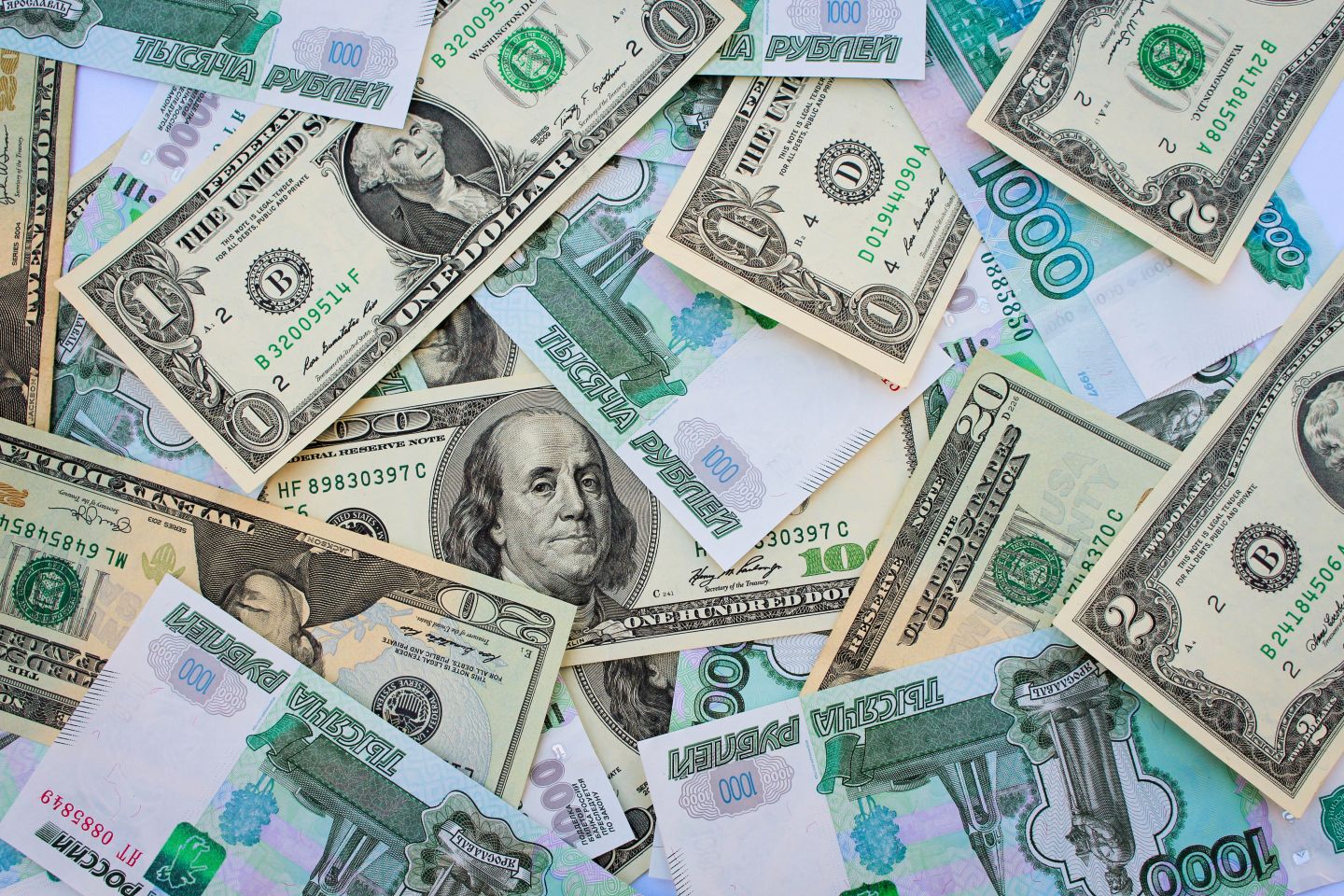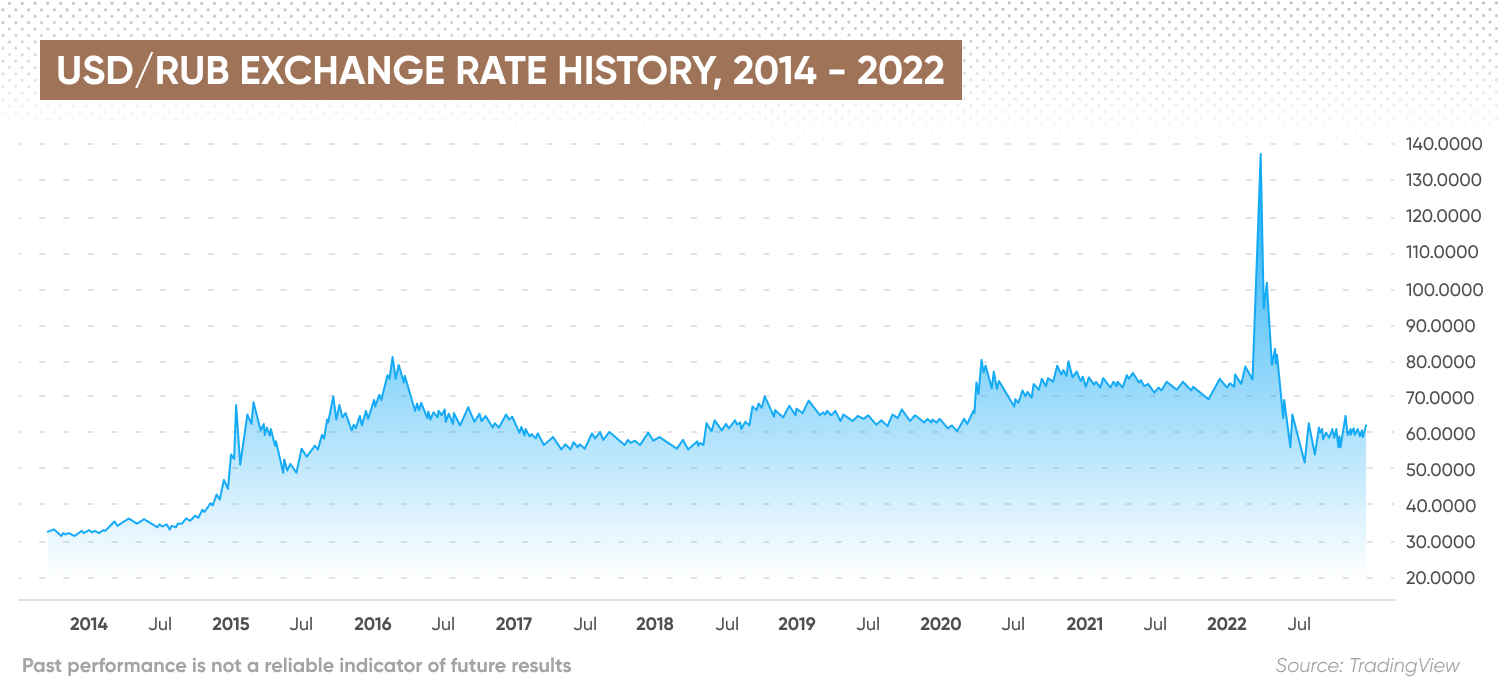USD/RUB forecast: Will the Russian ruble continue its outperformance against the dollar?
Will the US dollar gain against the Russian ruble in 2023? Read on for our USD/RUB forecast below…
The Russian ruble (RUB) emerged as the one of the top performing world currencies in 2022 despite economic sanctions placed on Russia by the West.
However, critics were sceptical about the ruble’s strength due to capital controls put in place by the Russian government to protect its national currency from depreciating.
How is USD/RUB expected to trade in 2023 and beyond? Here we take a look at the news that is shaping the USD/RUB forecast.
What is USD/RUB?
USD/RUB is the rate of US dollar (USD) in terms of Russian ruble (RUB). The exchange pair indicates the number of Russian rubles a person would get in exchange for one US dollar.
The US dollar is the world’s dominant reserve currency. A reserve currency is a currency that central banks across the world hold in large quantities.
According to the Congressional Research Service, global central banks hold about 60% of their foreign exchange reserves in the form of USD.
The Russian ruble is the national currency of Russia. It’s issued by the Bank of Russia. The ruble is known to be a commodity currency due to the Russian economy’s dependence on fuel and energy exports.
Ruble foreign exchange rates are correlated with global energy prices.
According to the International Energy Agency, Russia is among the world’s top three crude oil producers. Oil and natural gas revenues made up 45% of Russia’s federal budget in 2021.
USD/RUB historical rate
A study of historical USD/RUB rate over the last decade showed a clear correlation of ruble weakness with falling oil prices.

Going back to 2014, historical charts showed that USD/RUB rates posted a yearly gain of about 80% as USD surged against RUB from an exchange rate of 32.88 to 59.2 by the end of the year.
According to the World Bank, oil prices saw one of the largest declines since the Second World War between 2014 and 2016 due to a supply glut from booming US shale oil production and weak energy demand prospects.
Between 2017 and 2019, USD/RUB exchange rates were comparatively stable as the pair traded range bound between 55.5 and 70.6.
The crash of crude oil prices following the start of the Covid-19 pandemic supported USD/RUB rates in 2020.
The USD/RUB pair was volatile in 2022. The start of the Russia-Ukraine war sent the ruble crashing, while the US dollar surged amid a capital flight to the safe haven currency.
USD/RUB live exchange rate
USD/RUB rates surged over 36% in February 2022. By 7 March 2022, the USD/RUB exchange rate had jumped to an all-time high of over 154 following a ruble crash as the West imposed economic sanctions on Russia.
However, USD/RUB rates retreated to pre-war levels of about 80 within a month as the Russian government imposed capital controls to protect its currency.
Between March and June 2022, USD/RUB rates saw four straight months of losses. USD fell to a near seven-year low of 50.65 against RUB on 29 June 2022 as crude oil prices above $100 per barrel supported the ruble.
The World Economic Forum said in July 2022:
The performance of the ruble against the US dollar was in sharp contrast to other world currencies that were tumbling against the greenback following a policy of aggressive rate hikes by the US Federal Reserve (Fed).
The US dollar index (DXY), which tracks the performance of USD against a basket of six developed economy currencies, surged to an all-time high of over 114 points on 28 September 2022.
In parallel, the ruble emerged as the top performing world currencies in 2022. As of 2 December, USD has fallen about 17% year-to-date against RUB.
Western sanctions fail to stem Russian energy export
A combination of elevated energy prices, demand for Russian energy imports and capital controls have supported the ruble during the year.
While the European Union nations have been actively reducing their share of Russian energy imports, Russia has seen an increase in demand from Asian countries, notably India and China, due to the market discounts on Russian crude.
Natural gas exports to China hit record highs in September 2022 as Asia’s largest economy imported Russian gas “in excess of contractual obligations” via the Power of Siberia gas pipeline in the third quarter of 2022, reported the Bank of Russia.
The Bank of Russia’s trade statistics revealed that the value of Russian exports in the first nine months of 2022 exceeded the value from the corresponding period a year ago.
Capital controls
Russia managed to create extra demand for the ruble by demanding its trade partners to pay for imports in the Russian national currency. Russia also promoted the Mir payment system following the exclusion of Russian banks from the global payment system called SWIFT.
In August, Turkish president Tayyip Erdogan announced that Turkey will start using Russia’s Mir payment system to facilitate its payment for energy imports in rubles.
Additionally, the Bank of Russia banned Russian banks from selling foreign currencies in exchange for rubles and restricted customer withdrawals from existing foreign currency accounts to a maximum of $10,000 for six months between March and September 2022.
The central bank also implemented a massive rate hike to take benchmark rates from 9.5% to 20% on 28 February 2022 and carried out extensive foreign currency interventions to the tune of multi-billion dollars in order to support the ruble.
The aforementioned capital controls attracted sceptics who have called ruble’s strength “artificial”.
USD/RUB forecast for 2023 and beyond
Now that we've looked at the developments supporting the ruble in 2022, let's talk about US rate hikes, oil prices and Russia’s economic outlook, all of which will be influential for the USD/RUB forecast for 2023 and beyond.
As of 2 December, the US dollar index was trading at a five-month low, which indicated that the market had priced in reduced support for the USD in the form of slower-paced rate hikes from the US Fed.
“The market has been expecting the shift to a 50bp versus 75bp rate hike for a while, although it felt the need to price the terminal rate next summer some 10bp lower at 4.90%,” said ING Think on 1 December.
“We are tempted to say that looks an overreaction in that while Chair Powell did acknowledge the slowing in the pace of hikes, his core message was one of stubbornly high core inflation, particularly in the core services ex-housing category,” added ING Think.
As for oil prices, Warren Patterson, Head of Commodities Strategy at ING Think said ban of Russian imports and OPEC+ supply cuts will support prices in 2023 despite “demand impact from slowing global growth.” Patterson added:
Meanwhile, the economic forecast for the Russian Federation turned gloomy following partial mobilisation in the country which is expected to dent consumer demand in the near-term.
The Bank of Russia forecasted a recession in the country and expected positive GDP growth to start only from the second half of 2023.
In its dollar to ruble forecast as of 2 December Trading Economics saw the pair trading range bound in the near-term. The economic data firm said USD/RUB was expected to trade at 64.69 by the end of December 2022, a slight increase from its current rate of 62.
Trading Economics’ long-term dollar to ruble prediction was bullish as it expected USD/RUB to trade at 83.13 in a year’s time from 2 December 2022.
In its USD/RUB forecast for 2025, algorithmic price prediction website Wallet Investor saw USD/RUB closing 2025 at 64.851. The site fell short of a USD/RUB forecast for 2030 but saw the pair trading at 66.11 in January 2027.
Note that analysts’ and algorithm-based price USD/RUB forecasts can be wrong and shouldn’t be used as a substitute for your own research. Always conduct your own due diligence before trading, looking into the latest technical and fundamental analysis, global news and analysts’ commentary.
Remember that past performance does not guarantee future returns. And never trade money you cannot afford to lose.
Stay up to date with the major forex pairs using our currency strength meter.
FAQs
Why has USD/RUB been dropping?
USD has depreciated against the ruble in 2022 due to capital controls imposed by the Russian government to support the ruble and due to elevated energy prices.
Will USD/RUB go up?
In its dollar to ruble forecast as of 2 December Trading Economics saw the pair trading range bound in the near-term. The economic data firm said USD/RUB was expected to trade at 64.69 by the end of December 2022. Note that their predictions can be wrong.
Is the Russian ruble getting stronger ?
The Russian ruble emerged as the top performing world currencies in 2022. As of 2 December, USD has fallen about 17% year-to-date against RUB. Note that past performance does not guarantee future returns.
Is USD/RUB a buy, sell or hold ?
You should conduct your own research before trading foreign exchange currency pairs. Remember that past performance does not guarantee future returns. And never trade money you cannot afford to lose.